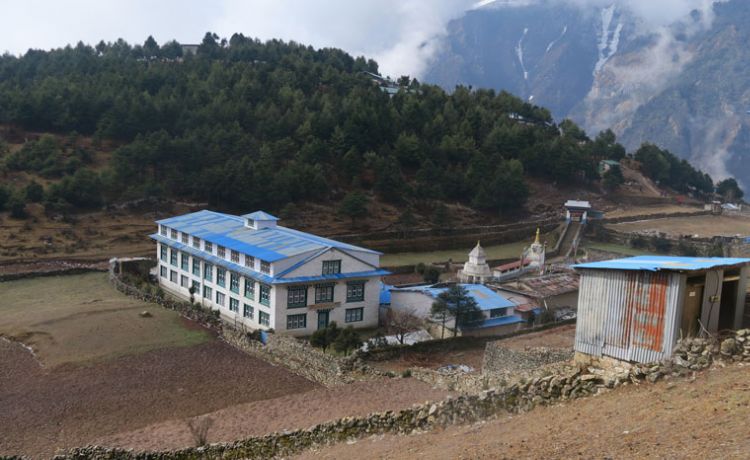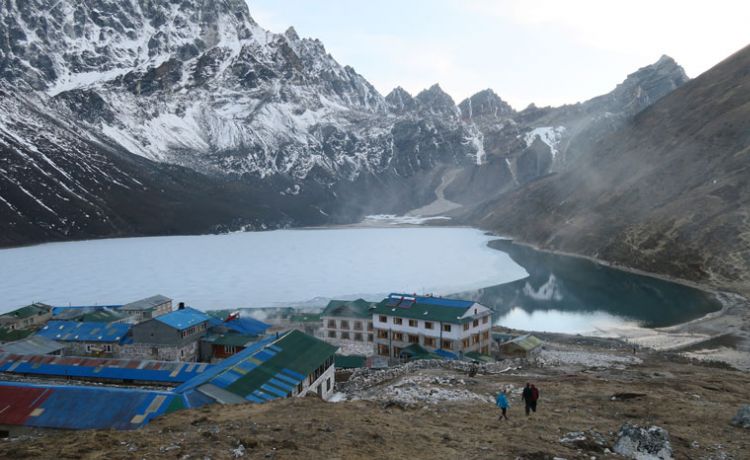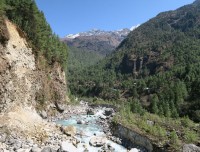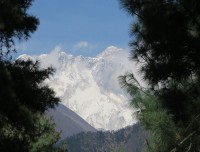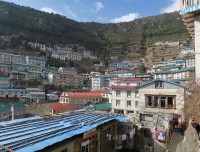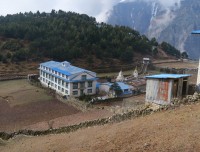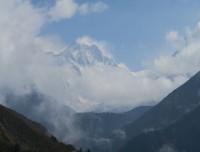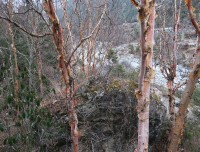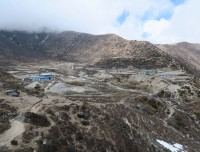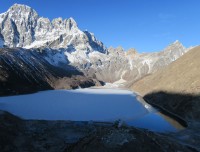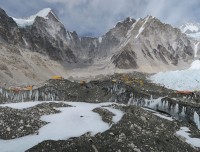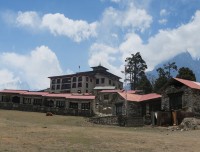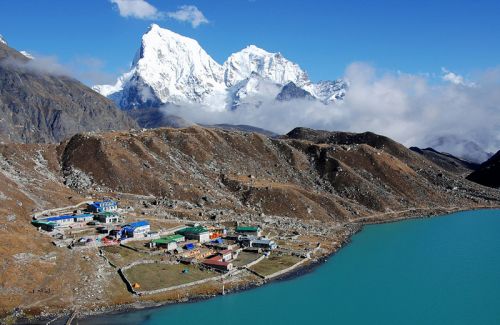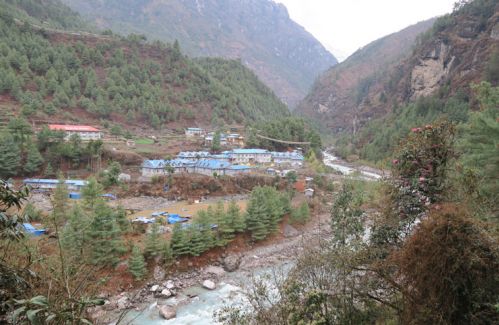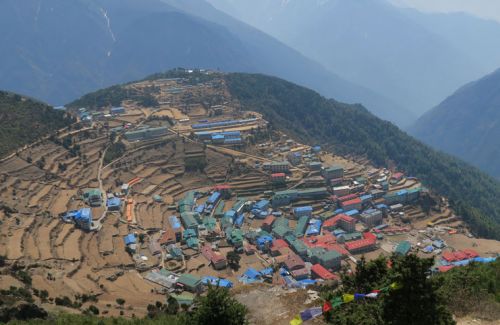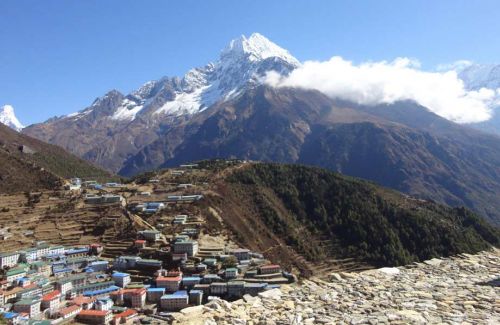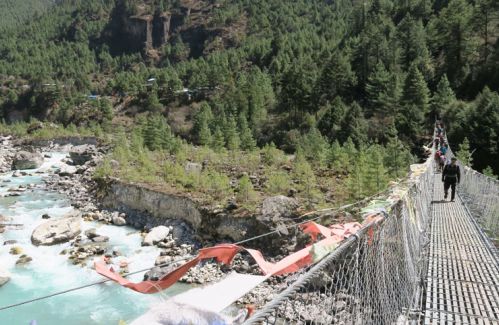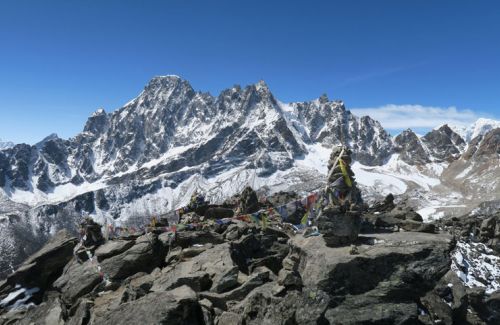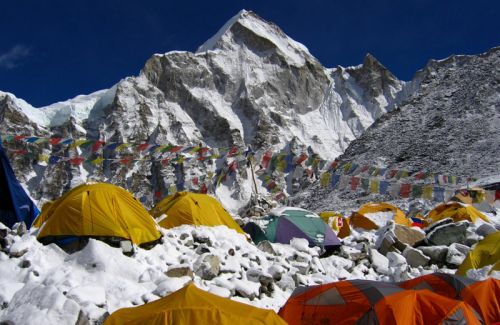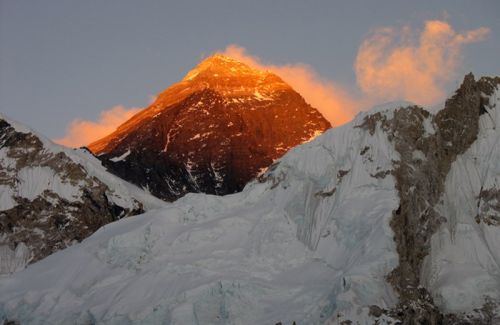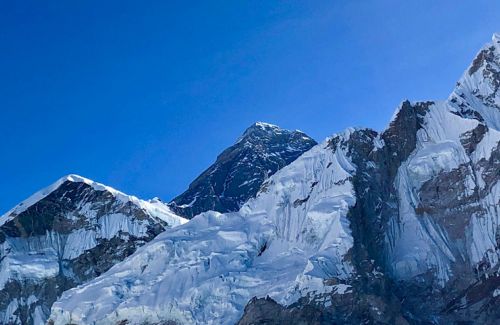Classic Everest Trekking
- Duration23 Days
- Max. Altitude5,545 m
- Starts FromUSD 1890
Destination:Nepal
Trip Grade:Strenuous (****)
Meals:Breakfast + Lunch + Dinner
Transportation:Private Vehicle / Aeroplane
Accommodation:Lodge
Trekking Region:Everest Region
Show AllClassic Everest Trekking combines the trek from Jiri to Gokyo and finally to Everest Base Camp that offers the densely populated middle hills and Solukhumbu’s deep canyons, tall ridges while Khumbu comprises the spectacular, harsh landscape of Everest, its attendant lesser peaks and glaciated valleys. The Jiri (1,905 m) walk- in is the most popular Everest approach, an old way,and was trekked by Sir Edmund Hillary and Tenzing Norgey Sherpa who first climbed Mt. Everest in 1953.
The Jiri to Everest Base Camp Trek route is very straightforward. The innkeepers along the trail are reasonably accustomed to serving westerners. The trek to Jiri - Everest Base Camp route passes through some culturally alive Sherpa villages where we can meet irrepressible Sherpas, feel their hospitality, active monasteries. We can encounter Sherpa yak drivers transporting goods over the high mountain passes.
After we reach to Bhandar and Junbenshi, we can do side trips at Thodung where there is the cheese factory and the Thubten Chholing Gumba north of Junbenshi, are fascinating. The way leads to eastward through the forested hills of souls and over the Lamajura Pass (3,530 m). Then , we reach to Lukla, the well trodden route to Khumbu. The trail north from Lukla is the trunk route of the Everest trek. From Lukla, the trail meanders north along the Dudh Koshi before bounding up to Namche Bazaar (3,450m) – nestled handsomely in a horseshoe bowl, the Sherpa “capital” has done very well out of mountaineering and trekking over the years.
Beyond Namche Bazaar, the trail veers north east and climbs to Tengboche from where anyone can view majestic peak Ama Dablam then continues to Pangboche where there is Khumbu’s oldest Gumba. Pheriche (4,250 m) has a site of Himalayan Rescue Association Post. From Pheriche, the route bends north again, ascending the moraine of the Khumbu glacier and passing a series of monuments to Sherpas killed on Everest, to reach Lobuche. The way we reach to KalaPatthar via Gorakshep. This is the vantage point for the grandeur view of not only of Everest but also of Lhotse, Nuptse as well as the sugar loaf of Pumori (7,165 m). A separate day trip can be made across the amazing Khumbu Glacier to Everest Base Camp.
The scenery is every bit as good at Gokyo Lakes in the next valley to the west. We can go to Gokyo from Gorakshep, crossing Cho La Pass and descending a slope, then to Tengboche following Dudhkoshi, north to Gokyo,set beside the immense Ngozumpa Glacier.This Jiri to Base Camp trek can be done easily acclimatizing one after the another geographically varied regions. Prior experience isn’t necessary but treks in this region require extra effort. So, this detail information regarding the trek would help you to figure it out how long and what grade trip suit for you.
Trip Highlights
- Full day sightseeing at UNESCO World Heritage Sites in Kathmandu
- To experience middle hill to the high altitude area, and the cultural activities
- Visit the Thubten Chholing Gumba
- Crossing Lamajura Pass
- Explore Sherpa Museum in Namche Bazaar
- Cho - La Pass and Ngozumpa glacier
- Tengboche Monastery and the monks activities
- Many ethnic groups of the low hilly region
- Sherpa people and their culture in the higher altitude
Day to Day Itinerary
Day 01:Arrival in Kathmandu (1,350 m) and Transfer to Hotel. Overnight at Hotel
Day 02:Kathmandu Sightseeing,Trek Preparation and Briefing about the trek. O/N at Hotel
Day 03:Drive from Kathmandu to Jiri (1,905 m), 7 hrs. O/N at Lodge
Day 04:Trek from Jiri to Bhandar(2190 m), 6-7 hrs, O/N at Lodge
Day 05:Trek from Bhandar to Sete(2645 m), 6-7 hrs, O/N at Lodge
Day 06:Trek from Sete to Junibenshi(2675 m) , 6-7 hrs, O/N at Lodge
Day 07:Trek from Junibenshi to Nunthala (2440 m), 6-7 hrs, O/N at Lodge
Day 08:Trek from Nunthala to Kharikhola (2020 m), 6-7 hrs, O/N at Lodge
Day 09:Trek from Kharikhola to Puiyan (2700), 6-7 hrs, O/N at lodge
Day 10:Trek from Puiyan to Phakding(2652 m), 6-7 hrs, O/N at Lodge
Day 11:Trek from Phakding to Namche (3440 m), 6-7 hrs, O/N at Lodge
Day 12:Acclimatization Day at Namche Bazaar. O/N at Lodge
Day 13:Trek from Namche to Dole (4200 m), 6 hrs, O/N at Lodge
Day 14:Trek from Dole to Machhermo (4470 m), 4 hrs, O/N at Lodge
Day 15:Trek from Machhermo to Gokyo (4790 m), 4 hrs, O/N at Lodge
Day 16:Hike to Gokyo Ri (5483 m) and back to hotel, then trek to Thangna (4500 m), 8 hrs, O/N at Lodge
Day 17:Cross Cho La Pass (5300 m) and trek down to Dzong La (4710 m). O/N at Lodge
Day 18:Trek from Dzongla to Everest Base Camp (5365 m) and back to Gorakshep (5180 m), 10 hrs, O/N at Lodge
Day 19:Hike to Kalapatthar (5545 m), back to hotel, then trek down to Pangboche (3985 m), 9-10 hrs. O/N at Lodge
Day 20:Trek from Pangboche to Namche Bazaar (3440 m), 7 hrs, O/N at Lodge
Day 21:Trek down from Namche to Lukla (2860 m), 6-7 hrs, O/N at Lodge
Day 22:Fly from Lukla to Kathmandu, 30 min. flight, Farewell dinner, O/N at Hotel
Day 23:Departure to the international Airport
Cost Include
- Airport Picks up and Drops off by private tourist vehicle
- Guided city tour by private tourist vehicle
- A full day sightseeing at UNESCO World Heritage Sites in Kathmandu
- A government licensed holder city Tour Guide
- 3 nights in Kathmandu in twin sharing basis 2-3 star hotels with Breakfast
- Flight from Lukla to Kathmandu
- Lodge to lodge accommodation during the trek
- Full Board meal (Breakfast + Lunch + Dinner) during the trek
- An experienced English Speaking Trekking Guide
- The required number of local staffs and Porter (2 Trekkers = 1 Porter)
- Food, accommodation, salary, insurance. equipment and medicine for guide and porter
- Sagarmatha National Park Entry Permit and TIMS Card for trekking
- Down Jacket, Duffel Bag and Sleeping Bag by Himkala Adventure (If required)
- Farewell Dinner in the typical Nepalese reataurant with Cultural Show
-
Government Taxes, VAT, and Service Charge
Cost Exclude
- Lunch and Dinner in Kathmandu
- Entrance fees in the Heritage Sites in Kathmandu
- Your Travel Insurance
- Nepal Entry Visa Fee
- Emergency Rescue and Evacuation
- Personal Expenses (Phone calls, laundry,bar bills, battery recharge, bottled or boiled water, shower etc)
- Tips for guide and porter
- Personal Trekking Equipment
-
Any other expenses which are not mentioned in Cost Includes Section
Detail Itinerary
Day 01Arrival in Kathmandu (1,350 m) and Transfer to Hotel. Overnight at HotelAfter the completion of your custom formalities, you will be met and greeted by Himkala representative.Then you will be taken to the hotel where you can enjoy the hot shower, take rest and free from jetlag. In the evening, you can go around Thamel exploring the touristic shops. Overnight at Kathmandu
Day 02Kathmandu Sightseeing,Trek Preparation and Briefing about the trek. O/N at Hotel After breakfast, around at 9 am, your guide will take you for the city tour to the historical-cultural things to show where you are impressed witnessing typical Newari architecture mostly of Malla period of 17th century. There are worth visiting Stupa in the high hill and the ornately decorated monasteries. You will have golden opportunities to observe the ritual activities by the local ethnic groups and the monks praying and circumambulating the stupas. After you come back to hotel, we brief you about the itinerary and other details about your trekking from the next day. Overnight at Kathmandu
Day 03Drive from Kathmandu to Jiri (1,905 m), 7 hrs. O/N at Lodge After breakfast, we set out for Jiri which is about 187 km north-east of Kathmandu. It is because of innumerable bends and the hilly areas; it takes 6-7 hours to Jiri. In spite of the narrow roads and jerky movement, the scenic beauty of Koshi River and the elegant mountain view of Ganesh, Langtang Lirung and Dorje Lakpa are more than one can expect. Overnight at Jiri
Day 04Trek from Jiri to Bhandar(2190 m), 6-7 hrs, O/N at Lodge After breakfast, we begin our trek from Jiri to Shivalaya which takes about 2 hours. We keep on continuing our trek ascending towards Deurali. We take lunch at Deurali. We descend about an hour from there and reach to Bhandar. Overnight at Bhandar
Day 05Trek from Bhandar to Sete(2645 m), 6-7 hrs, O/N at LodgeAfter breakfast, we gradually descend from Bhandar to Kinja which takes about 3 and half hours. We take lunch there at Kinja then the biggest climb of the journey, up to the Lamajura Pass (3,530 m) begins behind the town and follows a ridge on its south side through the oak forest to the small settlement; this is Sete, situated at an elevation of 2,575 m. It takes about 3 hours from Kenja to Sete.Overnight at Sete
Day 06Trek from Sete to Junibenshi(2675 m) , 6-7 hrs, O/N at LodgeAfter breakfast at Sete, the trail continues along the ridge in a prickly leaved oak forest. After an hour we reach to Dakchu (2,850 m). Another after an hour we arrive at Goyun (3,155 m) which is a small cluster of tea shops. Then the trail traverses through the fir forest. We reach to the main ridge striking north south and fork left to the Mani wall (3,444 m). We contour the impressive rhododendron grove to reach the Pass. The Pass is 3-4 hours from Sete. Despite the blockage by the Pass, the Mountain View is tempting. From the Lamajura Pass (4,010 m), the trail goes down and meets atTragdobuk, also called Taktor (2,860 m) in one and half hours. We continue to the north side of the valley and drop down to the valley of Junbenshi in an hour. Overnight at Junbenshi
Day 07Trek from Junibenshi to Nunthala (2440 m), 6-7 hrs, O/N at LodgeThe sightseeing around the village is full of great amenities especially the Serlo monastery above the village where the monks print ancient Buddhist texts from wooden blocks. After half an hour, the trail north of Junbeshi reaches to Thubten Chholing Gumba. The town of Mobung comes after continuing the east bank of Junbenshi Khola.Then the trail passes through the blue pine forest to rhododendron and prickly-leaved oak forest. After reaching open country, round the crest (3,048 m) of the Sailung ridge,we head north up the valley of the Ringmo Khola to the town of Sailung (2,953 m) about 2 hours from Junbenshi. From here the trail descends through oak forests crossing two tributaries and the main river of Ringmo Khola, we descend to the houses of Ringmo (2,805 m) within one and half hours from Sailung. From Ringmo,the wide trail ascends east through juniper forests and reach to Trashindho La Pass (3,071 m). From Trashindho the trail descends to the southeast, passes through forests and arrives at the Sherpa Village of Nunthala (2,440 m). Overnight at Nunthala
Day 08Trek from Nunthala to Kharikhola (2020 m), 6-7 hrs, O/N at Lodge After breakfast, we climb down passing terraces and reach to the bridge over the Dudh Koshi River (1,493 m)in one and half an hour from Nunthala. The trail crosses the river to the east bank and heads north to reach Namche Bazaar in three days. We follow the river for a while through the forests, and then climb through the terraces to reach the Rai village of Jubing (1,676 m) in 40 minutes. We climb through the village, round a ridge and plan for the high up notch in front of us. From the notch, we head towards the village of Kharikhola (2,020 m) inhabited by Sherpas. Overnight at Kharikhola
Day 09Trek from Kharikhola to Puiyan (2700), 6-7 hrs, O/N at lodgeWe woke up early, get breakfast and being active, start our trek. We cross the bridge over the Khari Khola, take the right fork and descend its north bank through the scattered settlement of Kharte. The trail continues to climb through this tributary valley into prickly-leaved oak and rhododendron forest. The ridge crest, Khari La (3,078 m) is 3 hours from KhariKhola We are almost a mile above the Dudh Koshi After passing steep slopes, go through the valley made by the tributary and descend 305 m and cross the tributary after an hour. We still continue to the north side of the valley to reach Puiyan (2,700 m) in half an hour. Overnight at Puiyan
Day 10Trek from Puiyan to Phakding(2652 m), 6-7 hrs, O/N at Lodge Continuing the crest of a ridge, Chtok La (2,945 m), leading down to the Dudh Koshi, we can reach the village of Surkhe (2293 m). We can view the Lukla airstrip and the grand view of sacred mountain Khumbila. The trail heads to the north to ChamriKharka. The trail from ChamriKharka passes through pleasant fields and climbs up a small ridge and reaches to Choplung. From Choplung, we head north and arrive at the village of Ghat (2,545 m). We proceed to the east bank through to Phakding (2,652 m). Phakding is half an hour from Choplung and 2 and half an hour from Lukla. Overnight at Phakding
Day 11Trek from Phakding to Namche (3440 m), 6-7 hrs, O/N at Lodge After breakfast, we cross the west bank of Dudh Koshi River, continue the lovely forests of rhododendron and pine, after an hour from Phakding, we reach to Benkar (2,905 m).Again, we keep on going for the journey and cross the Khyangshar Khola (2,773 m) and climb up towards Monjo (2,835 m) about 45 minutes from Benkar.We descend down to the Dudh Koshi River and cross the suspension Bridge to reach Jorsale (2,774 m) in 45 minutes. Then the trail leads straight and relatively steeply upward to the forest. The valley then becomes noticeably narrower, and we finally reach to another bridge, climb about 500 m up to the steep hill. The path leads still further up for about an hour then reaches to Namche Bazaar. Overnight at Namche
Day 12Acclimatization Day at Namche Bazaar. O/N at LodgeNamche Bazaar is the main,the most populated village of Sherpas in Khumbu region. The town has served everything we need. It’s because of small hydro power, the town has different charm. We can go for short hike to the nearby villages for our acclimatization. Overnight at Namche Bazaar
Day 13Trek from Namche to Dole (4200 m), 6 hrs, O/N at Lodge After rejoicing the morning beauty of Namche Bazaar, we gently climb up to the Chor Camp then continue to Kyangjuma (3,550 m). From Namche Bazaar to Kyangjuma via Chor Camp, anyone can be hypnotized by the astounding beauty of Mt Everest, Lhotse,Nuptse Ama Dablam, Thamserku, and others. From Kyangjuma, it is easy walk through rhododendron forest to Sanasa. The three different ways may be confusing for your further destination. The right hand side track goes to the Everest Base Camp directly. We follow the left hand side towards Phortse Tenga. From here, it is about one and half an hour steep incline to the Mongla Danda (3,978 m) with few tea shops and chortens. One can view Ama Dablam and other mountains tantalizing. We can have a short break here and enjoy the sights around. From Mongla Danda, the trail further plummets with numerous bends to Phortse Tenga. This is a small settlement with few lodges and tea shops. The interesting things we can see here is the water mills and the water driven prayer wheels around. From Phrtse Tenga, we climb up through the rhododendron and juniper forests and reach at Dole (4,090 m). Overnight at Dole
Day 14Trek from Dole to Machhermo (4470 m), 4 hrs, O/N at Lodge We further ascend gradually along the side of the valley. The trail traverses through many summer settlements. We can view the scintillating view of Cho-Oyu in the front and while going down the valley Kangtega and Thamserku. After passing Lhabarma (4,330 m) and Luza (4,340 m), we arrive at Machhermo. Overnight at Machhermo
Day 15Trek from Machhermo to Gokyo (4790 m), 4 hrs, O/N at Lodge It is the trek over the ridge climbing up and down valley to Kangtega. Again the trail goes up towards to Cho-Oyu (8201 m).Further than the ridge; the valley broadens as the trail passes through Pangka at 4390 m then descends to the river bank before beginning the climb onto the terminal moraine of the Ngozumpa Glacier. It is sheer ascent up the moraine; head towards the first small lake Longpongo (4,650 m) where a Brahmin ducks can be seen residing since long. After this, the trail further extends through the valley to a second lake known as Taboche Tsho (4,710 m). We can continue the trek to Gokyo (4,750 m). Overnight at Gokyo
Day 16Hike to Gokyo Ri (5483 m) and back to hotel, then trek to Thangna (4500 m), 8 hrs, O/N at Lodge This is the early morning hike to the Gokyo Ri, about 700 m high from the lodge. Getting ready with head light, aiming to grasp the tempting sun-rise view from the top of Gokyo Ri,(5,357 m), we keep on going piercing the steep, craggy surfaces to our destination. The startling view of Gokyo valley, the biggest Ngozumpa glacier and the series of stupendously beautiful Khumbu Mountains give an immense pleasure to the hikers. After that we descend back to the lodge, get our breakfast and after having breakfast at Gokyo, we gently descend down towards Thangna viewing natural beauty in an abundant measure. It is also the small settlement with lodges and tea shops at the shore of Ngozumpa glacier. This place can be taken as the gate way to the Cho La Pass. Overnight at Thangna
Day 17Cross Cho La Pass (5300 m) and trek down to Dzong La (4710 m). O/N at Lodge We start our trek before sunrise as we have to cross the Cho-La Pass (5,300 m), escaping from the vagaries of the weather in the day time. Considering all the precautions about altitude and the windy time, we finally descend and reach to Dzong La after an hour crossing Cho La Pass. Overnight at Dzong La
Day 18Trek from Dzongla to Everest Base Camp (5365 m) and back to Gorakshep (5180 m), 10 hrs, O/N at Lodge The trail goes ups and down above the snow fed lakes, passing through the mesmerizing peaks Cholatse, Taboche and the Chola Glacier. We follow the down trail with the magnificent view of AmaDablam, turn towards north, go down to the valley at the end of Khumbu glacier and reach to Lobuche. This can be the proper place for accommodation for today’s trek because if we further go to the next destination, Gorakshep can be very far still 3 more hours. We proceed towards the Everest Base Camp through the Gorakshep Lake. We pass the Indian Mountaineer’s Memorials after following the same trail from Gorakshep Lake. You might feel uneasy because of thin air in the high altitude through rocky ridges, moraine and streams before we reach to the Everest Base Camp. It is place from where we can view colorful tents standing and the brilliant scene of Nuptse, Khumbutse and Pumori. We return back to Gorakshep for the overnight stay. Overnight at Gorakshep
Day 19Hike to Kalapatthar (5545 m), back to hotel, then trek down to Pangboche (3985 m), 9-10 hrs. O/N at Lodge We are hiking up to KalaPatthar in the early morning for the sunrise and its mild sunrays over the top of Everest slowing coming down and the varied color to witness is not less than any heavenly pleasure. The morning clear view of Mt. Everest and other adjacent peaks are indescribable. From KalaPatthar, without any delay, we go to climb the rocky outcrop near to the summit marked by cairns and prayer flags. After getting adorable sight, we trek down to Pheriche which is about 4 hours trek. Pheriche was once a temporary yak herding area. But now it has got different look with hotels and lodges. There is a Trekkers’ Aid Post set up by Himalayan Rescue Association in 1973. The valley is cold and doesn’t get early light. From Pheriche the trail descends to Pangboche (3,860 m) where the gumba is worth visiting. Overnight at Pangboche
Day 20Trek from Pangboche to Namche Bazaar (3440 m), 7 hrs, O/N at Lodge After breakfast, we begin our trek to Namche Bazaar via Tengboche monastery. We spend half an hour inside the monastery premises and we behold the smiling Mt Everest from the high altitude monastery of this region.We trek down about 3 hours to Namche Bazaar. Overnight at Namche Bazaar
Day 21Trek down from Namche to Lukla (2860 m), 6-7 hrs, O/N at LodgeFrom Namche Bazaar to Phkading is about 5 hours trek climbing down through rocky terrain. We pass few Sherpa villages and the bridges on the way. There is no risk of altitude sickness but walking fast down to the slopes is not as easier as you think. After arrival at Phakding, we can take hot shower and get involved in the activities as we want. It is an easy, 2 and half hours trek from Phakding to Lukla. We go down to the valley and ascend to the Lukla airstrip. This is how you conclude your panoramic tour in Khumbu region. You can have rest and walk around there and explore the things around before you depart the next day. Overnight at Lukla
Day 22Fly from Lukla to Kathmandu, 30 min. flight, Farewell dinner, O/N at Hotel This is our morning flight again recapturing the wonderful mountain vista through your camera in 40 minutes flight from Lukla to Kathmandu. You will be greeted and transferred to hotel. You can make a plan for further activities if you are not very much tired. The evening celebration dinner will be together with the member of Himkala Adventure
Day 23Departure to the international AirportWe transfer you to Tribhuvan International Airport, 3 hours before you fly to the next destination. With warm feeling, showing gratitude to you that you joined Himkala for Everest Circuit Trekking, our represents departs from airport and you go ahead for custom formalities. Namaste with palms together
Trip FAQ
Himkala Adventure would like to answer all the queries about Jiri to Everest Trekking for all curious travelers/trekkers in the world. As you are entirely from different geographical location, you could better to know everything about the treks from the beginning i.e. airport pick up till your departure like airport picks up, drops off, accommodation in city, in the trek, guide and porters, safety for the trekking, food and accommodation and some other things that you might face on the way. Hope our endeavor listing these questions answers will help you self informed.
This is simply the outlines of the services we offer but it may differ as per your requirement, number of trekkers. What we go through our conversation, we will manage the means of transportation, hotels in the city, accommodation in the trekking, numbers of porters etc. This is general idea about Classic Everest Trekking before your trip and you become clearer about the trek. Please feel free to contact us to get more information about the trekking in the Himalayas of Nepal.
1) How is Classic Everest Trekking in Nepal?
Classic Everest Trekking is the route from Jiri to Everest Base Camp via Gokyo Lake which was followed by the first time Everest summitter Sir Edmund Hillary and Tenzing Norgey in 1953 A D. This is the trekking that goes through the hilly region to the alpine Khumbu region, and the best trek for acclimatization.This is the blending of all sorts of cultural and natural phenomenon.
2) What physical fitness do I need to book this trip?
Every trekking in the Himalayas of Nepal requires the certain level of physical and mental fitness. So, we advise you to be in good physical shape and able to feel comfortable while hiking up and down 7 to 12 miles per day on a trail carrying a day pack of about 10 pounds. Three things could make you confident enough for any trek you would like to do: aerobic, strength and mental.
Aerobic conditioning is important primarily because you will be trekking in Exciting mountain flight over the mountains from Kathmandu - Lukla - Kathmandu
up to 40% less than at sea level. With good aerobic conditioning, you will be able to better metabolize whatever oxygen is available to you. You should plan on doing at least one hour of aerobic 3 /4 times per week for 1 month or more before your arrival in Nepal. Walking, jogging, cycling, hiking on valley floor to ridge line ascents with day back are some of the excellent forms of exercise, so long as you are strengthening leg muscles and building stamina. Speed is not the essence; stamina, confidence and continuity are. Do as much uphill as possible. If you live in flat area, go to the stadium and use the steps with your pack.
3) Is the Classic Everest Trekking hard or easy?
Classic Everest Trekking can be easy and very exciting if you could walk minimum 5 miles a day and does have aerobic shape (with doctor’s approval). The actual trekking is on mostly ground level with a few sections of hill sides - up and down. You should carry more than a light day pack with your jacket, snacks and water bottle. The important thing is that you should acclimatize yourself with higher altitudes for that you need to maintain your health, should have a large fluid intake and always in slow pace in the Himalayas.
4) Is it dangerous to trek to Classic Everest Trekking?
Yes or No, Yes, because if we do not take proper precautions of Altitude sickness, there is risk of life. So, one should quite aware what is going on. Next thing we have to be careful with the caravan of yaks, occasionally, there is an incident that trekkers get injured due to rock fall by the flock of yaks or who inadvertently bump them off the trail and go down steep to the hill side. So, be always on the uphill side when the yaks pass by!
5) Do I really need to use guide to Classic Everest trekking?
You are advised to use Guide so that you could feel safer in the unknown area because the guide can tell you the possible danger as they have guided in this region since long. Most importantly, the Himalayan weather is really unpredictable and the Guide can help you to take proper shelter. Nest advantage to be with Guide is you get more knowledge about local culture and you could have easy access to interact with the local people. In 2014, the Nepal Government clearly has stated that the trekkers should have a guide but still it is not seemed in the practicality.
6) How do I find Himkala Adventure for my pick up at the airport?
Our representative from Himkala Adventure will display a small board (placard) of company or your name outside the airport terminal. You will be driven to the hotel by our tourist vehicle.
7) What sort of accommodation do I get in Kathmandu?
Normally we provide standard rooms with twin sharing accommodations at three star or similar category hotels in Kathmandu including breakfast. Accommodation in these cities can be upgraded as per your request. But some of our packages are sold without accommodation in the city.
8) How are tea house facilities during Classic Everest Trekking?
Tea House is the combination of guest house, restaurant, and social hang out. Tea houses in Classic Everest Trekking area are highly professional though they are simple but with neat and clean lodging offering fine views and plain but fresh and hygienic food with friendly atmosphere Most of the Tea Houses have running water facility. Many of them have hot water available for bathing. But we discourage our groups from using water heated by wood as lack of firewood in most villages is a big environmental concern in Nepal.
9) What sort of accommodation do I get in trekking?
Guesthouses/Tea Houses/Lodges provide twin sharing single and double rooms and occasionally a dormitory which is basically clean with a mattress and a quilt or blanket. Our company provides the sleeping bag if needed but we always recommend having your own sleeping equipments. You have to share the room with your group member or sometimes with unknown traveler. The toilet is always outside the room with basic facilities.
10) What sort of foods, water and drinks can I expect in trekking?
The foods in the Himalayas are very simple. There are mostly the family members themselves to cook and serve the meal. They are simply trained but experienced because they have been offering such services for many years in this busy route. The food is hygienic, fresh and delicious. We recommend you to drink mineral water or the boiled or using water purification pills or drops.
Most of the foods are cooked in the kitchen of tea houses. They serve you with different varieties of delicious Nepali and continental dishes. The most popular Nepali food is daal bhat (rice and lentils) with some mixed vegetable curry. Garlic soup is popular as it helps you with acclimatization. You could better be vegetarian in the mountains. All hotels in cities and guesthouses in trekking serve the vegetarian food. You can find all common types of drinks like hot chocolates, coffee, tea, hot lemon with honey, ginger tea, soft drinks etc. you will have your breakfast and dinner at the lodges where you will be staying and lunch somewhere on the way to your next destination.
11) What mode of transportation do I use?
We will provide the private transportation for Airport/Hotel/Airport pick up and drop and sightseeing in Kathmandu Valley. We use transportation as based on our cost inclusion section. The transportation varies depending on your requirements at the time of booking the trip.
12) What is the best season for this trekking?
The best season for Classic Everest Trekking is spring (March to May) and autumn (September to December). These are the perfect time of the year for the breathtaking views of Himalayas with clear and sunny days. But the weather in the mountains is unpredictable.
13) What is the weather and temperature like during the trekking?
The climate in Nepal varies from place to place which can be categorized in different four main seasons. The main seasons in Nepal are spring (March to May), summer (June to August), autumn (September to November) & winter (December to February). The best season to travel in Nepal is autumn (September, October & November) & spring (March, April & May). Weather in the mountains is unpredictable. But the day temperature in Classic Everest Trekking is comfortable.
14) Who will be guiding me during this trip?
We provide the professional government license holder English speaking trekking guides for our entire trekking trip. We can also provide French, Spanish, Japanese, German or Italian speaking guides as per your preference with extra payment but not guaranteed. All guides will be Nepali people who are carefully selected on the basis of their appropriate experience, leadership skills and personality. They are all trained from Nepal Academy of Tourism and Hotel Management, certified and approved by the Tourism Department of Nepal government. We provide a different city tour guide to guide you in UNESCO World Heritage Sites in Kathmandu. They are the professional license holder guide specialized in culture, history, geography, iconography, archeology and religion with good command over English. Tour guides are specialized in city tour and trekking guides are more in the hiking and trekking in the Himalayas.
15) What sort of experience do your guides have?
Our entire city tour guides have bachelors to Master Degree academic education along with many months tour guiding training from Nepal Academy of Tourism and Hotel Management, Rabi Bhawan, Kathmandu, Nepal. They are fluent in spoken languages and informative about the sites in many aspects. They are quite experienced and dedicated to their job and responsibilities.
Our entire trekking guides have minimum Intermediate to Master Degree academic education with trekking guide training from Nepal Academy of Tourism and Hotel Management, Rabi Bhawan, Kathmandu, Nepal. Many of them are from villages. As they are local, they know more about the routes, necessary precaution to be taken and so on. They have spent many years exploring many parts of the country. They are trained in first aid and able to handle any situation easily. They speak good English and make you know about the places you visit.
16) May I charge my electronic gadgets during Classic Everest trek?
Most of the places in your tea houses have charging facilities. You can charge your devices by paying some extra money. It’s good if you bring TWO or THREE pin travel adapter and put your gadgets at warm place at night.
17) How much additional money is required for this trip?
It’s a very personal question as expenses depend on habit. Normally, in Kathmandu you can allocate about USD 10 to 15 per person per lunch or dinner. USD 10 to USD 15 per person per day will be sufficient to buy bottles of water, chocolates, pay for a hot shower during the trekking. Other personal expenses will be your own calculation.
18) What is the social and environmental responsibility of Himkala Adventure for this trip?
The situation of environment in Nepal is in considerable stage due to so many factors caused by global warming, human activities, and adverse effects of natural incidents. Nepal is in between two giant countries like China and Nepal. The ozone layer is depleting and the atmosphere is getting heated. So, its direct effect is to the Himalayas that the snow is melting day by day and the sea level is rising. It is due to population growth, people are clearing the forest and the soil is being eroded. As a part of society, and our trekking related activities are directly concerned with the social and environmental things. We are very conscious not litter in the open spaces, to manage garbage properly and make local people aware in this campaign. We are working together with other companies and taking these issues seriously.
19) What is the minimum number requirement for this trip?
We operate individual trip to the group joining trips for Classic Everest Trek. If you want to do any private trip we are ready to organize for solo traveler as well with some additional charges.
20) Are there communication or internet services during Classic Everest trek?
All guesthouses/lodges in Clasic Everest Trekking trails have telephones and internet services. They provide the WIFI service with some extra charge which helps to get updated with social Medias, friends or family. All our guides carry the local mobile phone. You can use his mobile phone to make any local or international call from trekking trails by paying him directly. You can even pass him number to be connected with your family or friends. We highly recommend taking local SIM card for call and internet services during trekking. Local SIM cards are easily available in many stores and at airport as well. You need to provide two copies of your photographs and your passport copy to get local SIM CARDS of NCELL & NTC (only these two companies provide telephone services in Nepal.
21) May I get chances for shower during Classic Everest Trek?
Most of the guesthouse provides hot shower with some extra cost. In few places, bucket water will be provided for the shower.
22) May I add extra days in trekking?
Classic Everest Trekking is the prime destination where one can feel stepping on the lap of highest mountain in the world. It is the matter of glory and pride that your dreams come true. If you have any more days spared, you could easily extend your trek with some side trips to the nearby Sherpa Villages or can deviate the other routes. If you would like to customize or shorten your trip, it is quite possible as well.
23) What happens in case of emergency?
Himkala Adventure has prepared for any emergency situation and knows how to handle it. Our guides are trained in first aid and can deal with most of the basic ailments that occur during the trek. Every client should have his own insurance before coming to Nepal for the case of emergency
24) Do I need to have insurance for this trip?
We request you to have a travel-insurance policy to cover theft, loss, medical problem & emergency helicopter evacuation from high altitude places before coming Nepal. Choose a policy to cover your emergency high altitude helicopter evacuation with all medical insurances for trekking in high altitude in the Himalayas of Nepal. Your travel insurance is always needed before going in any high altitude trekking. Please check your travel insurance policy which doesn’t exclude mountaineering or alpinism. Although you will not be engaging in these activities in your trekking, you might have problem convincing the insurance company of this fact. Rescue insurance need to cover an emergency helicopter evacuation or a charted flight from remote mountain trails of Nepal as well as international medical evacuation. A helicopter evacuation might cost US$ 2500 to US$10000 depending on the places. So that travel insurance to cover all above is must to travel in the high Himalayas of Nepal.
25) What is the baggage allowance from/to Kathmandu – Lukla flight?
There may be different baggage allowance as per the different airlines but in general, a traveler to/from Lukla is allowed to carry 10 kg of check-in luggage and 5 kg of carry-on hand luggage per person with his/her flight ticket. Excess baggage (up to 5 kg per person only) will be charged at 120 NPR per person at your own expense.
26) What type of shoes should I wear during Classic Everest Trekking?
You could better have carefully chosen hiking boots with extra laces which should be kind of strong, well-made but light boots for Classic Everest trekking. Shoes and boots are best to buy before arriving in Nepal. We advise you to wear your new shoes for sometime before trek so that you could feel well habituated on the newer trail for your feet.
27) Can I use credit cards in the Classic Everest Trekking route?
No, you can use only in the cities like Kathmandu. There are ATMs in Lukla and Namche Bazaar but one cannot rely upon. So, it is better you to make change in Kathmandu. When you are out of city, all you need is cash, better to have small notes. Please change the currency in local Nepali rupees before you go to the mountains.
28) What about extreme weather and airport closures in Lukla?
Weather conditions in the Himalayas are unpredictable. Flights can be cancelled or delayed due to bad weather. Flights to and from Lukla are particularly prone to travel delays. There is no other alternative except having patience for the good weather or have some optional trip around or chartering helicopters. You will be accommodated at your joining hotel in your own expense.
29) Do I need to tip my guide and porter? How much would that be?
Tipping is not mandatory, neither it is right to ask by anyone but it is a way of showing gratitude after taking service. The level of tip also shows how satisfy you are from the team that you had been during your tour/trek.
However, we recommend you to spend minimum 10% of your total trip cost for tipping entire local staffs, the ratio of tipping guide and porter will be given to you at the pre-trip meeting in Kathmandu before starting the trek.
30) How is Camping Trek to Jiri - Gokyo - Everest being operated?
Camping trek is fully organized and supported, with a team of guides, cooks, and porters to accompany you. Our porters carry all the trekking gear, food, fuel and personal belongings. Our cooks prepare hot meals. Trekkers need only carry a small bag as required for the day. At night, tents for dining, sleeping and ablutions tents are provided and set up, also mattresses and down-filled sleeping bags, tables and seating.In a typical camping trek, we start the day around 6 a.m. with a cup of hot tea. You are then provided with a bowl of warm water for washing. Then trekkers enjoy breakfast before leaving camp. The trek begins around 7.30 - 8 a.m.
Trekkers can set their pace for pausing and sightseeing and the walk to the lunch spot will normally take 3 hours. On arrival, you are served hot lunch. In the afternoon, after walking for another 3 to 4 hours, you arrive at the next camp around 5 p.m. Tea & snacks are served while our staff readies the camp. Dinner time is around 6/7 p.m. in the dining tent, lit with lanterns and comfortably furnished. The food is healthy, wholesome and hygienically prepared.
Trip Note
Cost:
The cost of trip varies according to the number in the group, the category of the Hotel, mode of the transportation and any kind of changes (if there is). So, if you would let us know all of these above mentioned things, then we could quote you the exact price.
Essential Documents:
You are requested to send the following documents after you confirm or book the trip with Himkala Adventure:
A copy of your passport and travel/health insurance documents with contact details, three passport size photos.
It is advised to maintain a separate photocopy of all important documents including traveler’s cheques, bank/ATM card, contact numbers, international flight tickets, and emergency contact numbers.
Weather:
The main trekking season in Nepal is from October to December and March to May. The day temperature for walking to Jiri - Gokyo - Everest Base Camp is comfortable. The sky is clear although there is snow and rainfall occasionally. It is about 10 degree centigrade at the height of 3,600 m and increasingly lower, the higher we go.
Transport:
A traveler to/from Lukla is allowed to carry 10 kg of check-in luggage and 5 kg of carry-on hand luggage per person with his/her flight ticket. Excess baggage (up to 5 kg per person only) will be charged at 120 NPR per person at your own expense.
Extreme Weather and Airport Closures:
Weather conditions in the Himalayas are unpredictable. Flights can be cancelled or delayed due to bad weather. Flights to and from Lukla are particularly prone to travel delays. There is no other alternative except having patience for the good weather or have some optional trip around or chartering helicopters. You will be accommodated at your joining hotel at your own expense.
Nepal Strikes:
There is much more progress in the political scenario in Nepal and we assure you that travelling in Nepal is safe. But there may be Bandha (wide transport strikes) at a very short notice. The shuttle bus is in operation by Nepal Tourism Board and the Nepal Tourist Police in conjunction with the Himalayan Rescue Association from domestic and international terminal to the various hotels in Kathmandu. The service costs 300 rupees per person.
Itinerary Disclaimer:
Himkala has thoughtfully designed all the itineraries but our itineraries are updated for the betterment on the basis of our past travelers’ comments and our own research. In case you find changes in the itinerary you printed and the upgraded one does not affect your trip. Please note that some changes may occur in our itineraries due to bad weather and common seasonal changes to timetables and transport routes.
Physical Rating:
Your trip will be meaningful if you could find yourself fit and fine. You will be walking up to 5,545 m from the sea level. As the geographical region varies, there is a temperature variation as well. So, we advise you to undertake regular physical exercise, jogging, hiking, riding, ascending and descending the long stairs etc.
Group Size:
Himkala Adventure organizes solo to group travelers. Our group trips are designed for sharing accommodation and there is no single supplement. Single travelers share with the same gender from twin to multi-share in an accommodation. You are requested to have mutual understanding in between the fellow travelers who have joined from the different parts of the world. Please remember that you have great responsibilities in the group. If you are requested to be at a particular place at a certain time, make sure that you have been there at a time. It is much more pleasing sharing experiences and traveling together.
Accommodation and Meals:
Accommodation and Foods in the Himalayan region of Nepal cannot be compared with any developed countries in the world. We know that you might not have experienced such things before but you should take it easy. Accommodations at local lodges are simple but clean and comfortable. The food is plain. Toilets and washing facilities are shared and rudimentary. In high altitude regions, there are very few tea houses and one has to be happy to share in simple dormitories without electricity, without running water. Hot shower means a bucket of hot water upon our request.
Money Matters:
Please note that most establishments in Asia will not accept foreign currency notes that are old, torn or faded and they can be very difficult to exchange or extra fees added when exchanging at banks. Please ensure that you have new, clean notes.
The official currency of Nepal is the Nepali Rupee (NPR). ATMs can be found only in major cities of Nepal like Kathmandu, Pokhara, Chitwan, Bhaktapur etc. The government of Nepal has banned the import, export and use of 500 and 1000 Indian rupee notes in Nepal. You make sure that you won’t carry these notes upon arrival in Nepal, otherwise they are confiscated and you may be fined.
Please make sure that the foreign currency notes that you have are new and clean notes because old, torn or faded foreign currency notes in Nepal are very difficult to exchange or extra fees added when exchanging at banks.
While travelers cheques have security advantages exchanging them can be a lengthy process, commissions can be high (up to 10%) and they can be difficult to change in rural areas, on weekends and public holidays. If you choose to bring travelers’ cheques, make sure they are a major brand and major currency.
Tipping:
Tipping is not mandatory. It is not anyone’s right asking for tips but if you are happy with the service, you could tip the staffs. It is entirely a personal preference. Tipping could be significant to them who took take great care of you in your traveling period. Himkala recommends that you could tip any intended recipient by any member of the group than collected and passed on by the group leader.
Note: Please do not tip with coins or dirty and ripped notes. This is culturally taken as an insult.
Local Dress in Nepal:
Nudity is a sensitive issue in Nepal. Women should avoid wearing shorts and sleeveless tops in public places where this might be seen as inappropriate. Remove shoes before entering certain holy places. Non-Hindus are not permitted in some temples.
Feedback:
Your feedback will be the great guidance to meet our target and to bring improvement in our service. What and how have you experienced with Himkala Adventure and our staff? Please write, we will read it carefully. One cannot see his/her shortcomings that are lying with them. Someone should point it out. We are always eager to hear from you.
Trip Info
- Himkala Crews
- Hypothermia
- Safety and Security
- Travel Insurance and Evacuation
- Trip FAQs
- Washing and Shower
- Water/Food and Nutrition
- Trip Grading
- Weather
- Accommodation/Shelter
- Altitude Sickness
- Communications and Updates
- Conservation
- Cross Cultural Issues
- Essential Do’s and Don’ts
- Foot Ware/Foot Care
- Health and Fitness
- Equipment List
